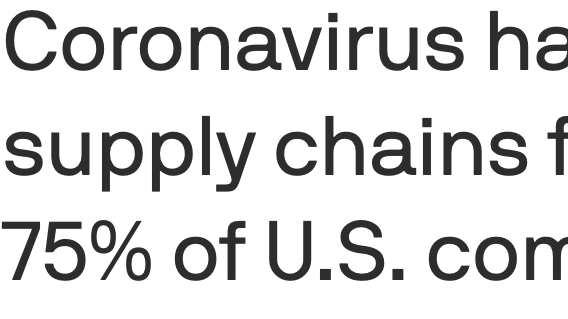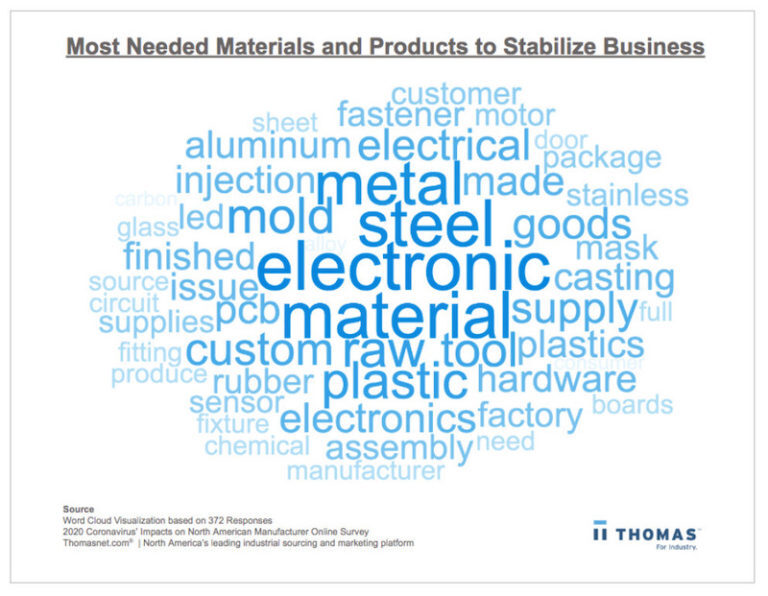
MacroFab Blog
With OEMs already reeling from the impact of tariffs, nearly 75 percent of companies are reporting a disruption in their supply chain as a result of COVID-19. As the world works through the impact of the changing trade policies and the coronavirus pandemic, there are practical steps supply chain teams can take now to get back on track and plan ahead.
A survey conducted by the Institute for Supply Chain Management focused on the impact of the outbreak in China. It revealed that 62 percent of companies report production delays, as manufacturers work at half their standard capacity. Visibility into lead times is at an all-time low, as 53 percent of companies are experiencing difficulties in getting information from their suppliers. Recommendations on planning for disruptions from ISM follow a logical progression:
- Diversify your supply chain
- Assume extra time for transportation delays
- Develop your long-term plan now
Diversify Your Supply Chain For Materials Sourcing
For most electronics production, component and materials sourcing is global, irrespective of the location of assembly factories; and supply chain sourcing will remain global. Few companies have visibility into where their electronic components are specifically produced. The most important step you can take now is to identify alternative sources before the disruption affects your production schedule.
Diversifying your materials pipeline means working with your contract manufacturer to eliminate single-source bottlenecks by putting alternative vendors in place. All substitutions and alternative parts take time to source and approve for production, so it’s worth reaching out to your CM early to develop a plan. The objective should be to preserve most of your existing supply chain, but ensure you have a Plan B if there are delays.
An experienced supply chain team at your CM can help you plan for disruptions because they have relationships with many authorized distributors and suppliers. These CMs will help manage your supply chain and can quickly call on their vendors to source alternatives for limited or out-of-stock components, generally at the same price point or better.
“In times like this, it isn’t about moving your supply chain out of China, but about managing it proactively and making it as bulletproof as possible,” said Misha Govhsteyn, CEO of MacroFab. “Having a more distributed, less concentrated supply chain improves your cost efficiencies by ensuring that your materials acquisition doesn’t get disrupted. As always, you pay a lot for emergencies, so we help our customers anticipate worst-case scenarios before they incur major costs.”
Eliminate Single Points of Failure Across Your Factories
While diversifying your materials sourcing is fairly straightforward, eliminating a single point of failure at your CM may be a lot more difficult. CMs with multiple facilities typically assign each customer to a specific factory, and moving between factories is anything but trivial.
Starting the conversation about how such a move will be executed has to happen before you see a production delay, not after. The best steps to take ahead of disruption are to assure that any CM you are working with has multiple factories available and is able to adjust your production flow quickly.
This is where digital manufacturing platforms such as MacroFab and Fictiv have a distinct advantage – these services aggregate a lot of factory capacity and assure that every job is placed in just the right facility every time. In effect, companies using this model are decoupled from their factories, while maintaining control and better visibility over their production. For example, MacroFab offers contract manufacturing services in Mexico, the USA, and Canada within a single platform.
According to Thomas, as much as 31 percent of companies reported turning down or delaying orders due to COVID-19 but your business can remain agile and avoid this outcome. Ultimately, factory portability is all about agility – the ability to continue to deliver products even under unforeseen circumstances. Digital manufacturing platforms are built for such agility by design.
Avoiding Transportation Delays

Reshoring OEMs
The easiest way to deal with transportation delays is to allocate more time for disruption across airports and global ports. But simply absorbing the long lead times is not always an option. Digital logistics platforms such as Flexport and Convoy can provide a lot of leverage and optionality, but the most impactful step OEMs can take is moving production as close to their customers as possible.
The biggest concern supply chain managers have is the ability to control costs as they consider alternatives to China, but in fact, digital factory networks span multiple countries, including low-cost manufacturing regions. This is where nearshoring your production to Mexico or even the US gives you the most leverage. Even as the southern border is effectively closed due to COVID-19, cargo still moves across the Mexican border, cutting the crucial transit time from Asia.
In the long term, nearshoring will become increasingly important as we decouple our supply chain from Asia and formulate a strategy to become more resilient to disruption in any form.
Embracing the Digital Manufacturing Model
While all manufacturers will remain dependent on Asia for materials acquisition, formulating a continuity plan based on factory portability will help avoid disruptions. Working with a CM that uses a digital platform as a “system of record” means that all manufacturing data, quotes, and orders are readily available at every step in the production process.
Changes that occur with each job are version controlled by tracking them from the point of order to the production facility. This level of process management enables factory portability and reduces delays.
Conclusion
We hope you, your family, and your staff stay healthy during this unprecedented time. It is critical to take necessary measures to keep them healthy so your business continues to operate with limited interruptions. At MacroFab, our overriding priority is the safety of our staff, and our ability to deliver our services in a consistent and reliable way.
Related Topics
Supply Chain Challenges Persist for Electronics Companies
We'll delve deeper into the supply chain challenges facing electronics companies and explore the impact on the quality outcomes of their products.
Electronics Nearshoring: Moving Past APAC Manufacturing Risks
It’s taken more than two years for supply chains to go back to normal, and even now, some industries continue to struggle as zero-COVID policies continue.
Webinar Recap: Building Supply Chain Resiliency
On May 12, we talked with Fictiv CEO, Dave Evans during a webinar hosted by industry journalist Philip Stoten about building supply chain resilience.
About MacroFab
MacroFab offers comprehensive manufacturing solutions, from your smallest prototyping orders to your largest production needs. Our factory network locations are strategically located across North America, ensuring that we have the flexibility to provide capacity when and where you need it most.
Experience the future of EMS manufacturing with our state-of-the-art technology platform and cutting-edge digital supply chain solutions. At MacroFab, we ensure that your electronics are produced faster, more efficiently, and with fewer logistic problems than ever before.
Take advantage of AI-enabled sourcing opportunities and employ expert teams who are connected through a user-friendly technology platform. Discover how streamlined electronics manufacturing can benefit your business by contacting us today.
